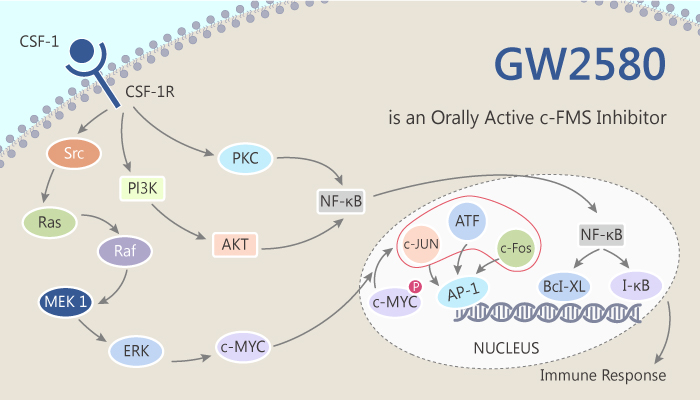In several diseases, colony-stimulating factor-1 (CSF-1) signaling via cFMS receptor kinase is increased. CSF-1 can promote the survival, proliferation, and differentiation of mononuclear phagocyte lineage. CSF-1 exerts its activities by binding to cFMS receptors on cell surface, which leads to the autophosphorylation of cFMS receptor kinase. It then causes cascade reactions of intracellular signals. The CSF-1-cFMS-receptor pathway is up-regulated in human pathologies, which involve chronic activation of tissue macrophage populations. Therefore, it may become the target of drug treatment. Moreover, Synovial fibroblasts of patients with rheumatoid arthritis produced high levels of CSF-1. And this indicates that CSF-1 plays a role in joint degradation. The increasing production of CSF-1 matters with inflammatory bowel disease, glomerulonephritis, allograft rejection, tissue macrophage accumulation seen in atherosclerosis. GW2580 is an orally bioavailable and selective cFMS kinase inhibitor.

GW2580 is an orally bioavailable, potent and selective cFMS kinase inhibitor and it inhibits human cFMS kinase in vitro at 0.06 μM. Furthermore, GW2580 of 1 μM completely inhibits the growth of mouse M-NFS-60 bone marrow cells and human monocytes induced by CSF-1. At the same time, it completely inhibits bone degradation in human osteoclasts, rat skulls, and fetal long bone cultures. After oral administration, GW2580 blocks the ability of exogenous CSF-1 to increase LPS-induced IL-6 production in mice. GW2580 also inhibits the growth of CSF-1-dependent M-NFS-60 tumor cells in the abdominal cavity. In addition, GW2580 reduces the accumulation of peritoneal macrophages after the injection of mercaptoacetate. Unexpectedly, GW2580 inhibits LPS-induced TNF production in mice. All in all, GW2580 is an orally bioavailable, potent and selective cFMS kinase inhibitor. Besides, GW2580 has the ability to inhibit CSF-1 signal transduction through cFMS kinase in normal cells and tumor cells in vivo.
References:
Conway JG, et al. Proc Natl Acad Sci U S A. 2005 Nov 1;102(44):16078-83.